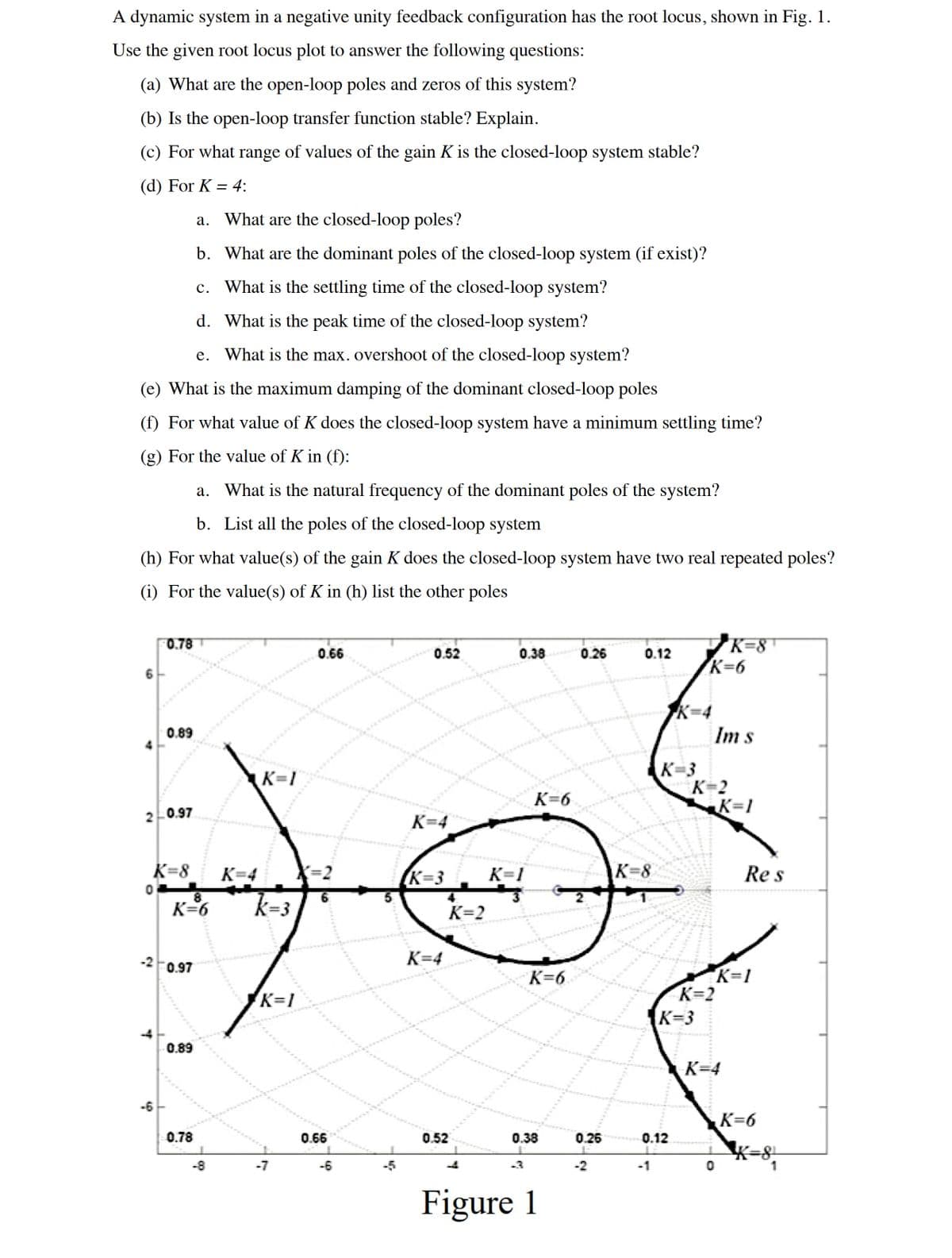A dynamic system in a negative unity feedback configuration has the root locus, shown in Fig. 1. Use the given root locus plot to answer the following questions: (a) What are the open-loop poles and zeros of this system? (b) Is the open-loop transfer function stable? Explain. (c) For what range of values of the gain K is the closed-loop system stable? (d) For K = 4: a. What are the closed-loop poles? b. What are the dominant poles of the closed-loop system (if exist)? c. What is the settling time of the closed-loop system? d. What is the peak time of the closed-loop system? e. What is the max. overshoot of the closed-loop system? (e) What is the maximum damping of the dominant closed-loop poles (f) For what value of K does the closed-loop system have a minimum settling time? (g) For the value of K in (f): a. What is the natural frequency of the dominant poles of the system? b. List all the poles of the closed-loop system (h) For what value(s) of the gain K does the closed-loop system have two real repeated poles? (i) For the value(s) of K in (h) list the other poles 6 2 0.97 0 0.78 T K=8 -2 0.89 6 K=6 0.97 0.89 0.78 -8 K=4 k=3 K=1 -7 0.66 X=2 6 0.66 -6 5 -5 0.52 K=4 (K=3 K=4 K=2 0.52 0.38 K=1 K=6 -3 K=6 0.38 Figure 1 0.26 0.26 -2 0.12 K=8 -1 K=3 0.12 K=4 K=6 K=3 Im s K=2 K=2 K=8 K=1 K=4 0 K=1 Res K=6
A dynamic system in a negative unity feedback configuration has the root locus, shown in Fig. 1. Use the given root locus plot to answer the following questions: (a) What are the open-loop poles and zeros of this system? (b) Is the open-loop transfer function stable? Explain. (c) For what range of values of the gain K is the closed-loop system stable? (d) For K = 4: a. What are the closed-loop poles? b. What are the dominant poles of the closed-loop system (if exist)? c. What is the settling time of the closed-loop system? d. What is the peak time of the closed-loop system? e. What is the max. overshoot of the closed-loop system? (e) What is the maximum damping of the dominant closed-loop poles (f) For what value of K does the closed-loop system have a minimum settling time? (g) For the value of K in (f): a. What is the natural frequency of the dominant poles of the system? b. List all the poles of the closed-loop system (h) For what value(s) of the gain K does the closed-loop system have two real repeated poles? (i) For the value(s) of K in (h) list the other poles 6 2 0.97 0 0.78 T K=8 -2 0.89 6 K=6 0.97 0.89 0.78 -8 K=4 k=3 K=1 -7 0.66 X=2 6 0.66 -6 5 -5 0.52 K=4 (K=3 K=4 K=2 0.52 0.38 K=1 K=6 -3 K=6 0.38 Figure 1 0.26 0.26 -2 0.12 K=8 -1 K=3 0.12 K=4 K=6 K=3 Im s K=2 K=2 K=8 K=1 K=4 0 K=1 Res K=6
Power System Analysis and Design (MindTap Course List)
6th Edition
ISBN:9781305632134
Author:J. Duncan Glover, Thomas Overbye, Mulukutla S. Sarma
Publisher:J. Duncan Glover, Thomas Overbye, Mulukutla S. Sarma
Chapter12: Power System Controls
Section: Chapter Questions
Problem 12.3P
Related questions
Question
100%

Transcribed Image Text:A dynamic system in a negative unity feedback configuration has the root locus, shown in Fig. 1.
Use the given root locus plot to answer the following questions:
(a) What are the open-loop poles and zeros of this system?
(b) Is the open-loop transfer function stable? Explain.
(c) For what range of values of the gain K is the closed-loop system stable?
(d) For K = 4:
a. What are the closed-loop poles?
b. What are the dominant poles of the closed-loop system (if exist)?
c. What is the settling time of the closed-loop system?
d. What is the peak time of the closed-loop system?
e. What is the max. overshoot of the closed-loop system?
(e) What is the maximum damping of the dominant closed-loop poles
(f) For what value of K does the closed-loop system have a minimum settling time?
(g) For the value of K in (f):
a. What is the natural frequency of the dominant poles of the system?
b.
List all the poles of the closed-loop system
(h) For what value(s) of the gain K does the closed-loop system have two real repeated poles?
(i) For the value(s) of K in (h) list the other poles
2
-2
ip
0.78
0.89
0.97
K=8
K=6
0.97
0.89
0.78
K=1
0.66
K=4 X=2
k=3
K=I
0.66
LD
ch
0.52
K=4
(K=3
K=4
K=2
0.52
0.38
K=I
K=6
K=6
0.38
Figure 1
0.26
WEL
0.26
0.12
K=8
K=3
0.12
K=8
K=6
K=3
K=2
K=2
Im s
K=1
Res
K=1
K=4
K=6
Expert Solution
This question has been solved!
Explore an expertly crafted, step-by-step solution for a thorough understanding of key concepts.
This is a popular solution!
Trending now
This is a popular solution!
Step by step
Solved in 4 steps with 1 images

Knowledge Booster
Learn more about
Need a deep-dive on the concept behind this application? Look no further. Learn more about this topic, electrical-engineering and related others by exploring similar questions and additional content below.Recommended textbooks for you

Power System Analysis and Design (MindTap Course …
Electrical Engineering
ISBN:
9781305632134
Author:
J. Duncan Glover, Thomas Overbye, Mulukutla S. Sarma
Publisher:
Cengage Learning

Power System Analysis and Design (MindTap Course …
Electrical Engineering
ISBN:
9781305632134
Author:
J. Duncan Glover, Thomas Overbye, Mulukutla S. Sarma
Publisher:
Cengage Learning